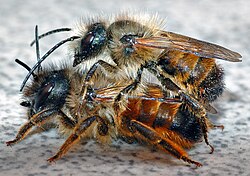Mason bee
| Mason bee | |
|---|---|

| |
| Osmia rufa | |
| Scientific classification | |
| Kingdom: | |
| Phylum: | |
| Class: | |
| Order: | |
| Family: | |
| Subfamily: | |
| Tribe: | |
| Genus: | Osmia Panzer, 1806
|
| Species | |
|
Osmia bicolor | |
Mason bee is a common name for species of bees in the genus Osmia, of the family Megachilidae. They are named from their habit of making compartments of mud in their nests, which are made in hollow reeds or holes in wood made by wood boring insects.
Species of the genus include the orchard mason bee, Osmia lignaria, the blueberry bee, O. ribifloris, and the hornfaced bee, O. cornifrons. The former two are native to the Americas and the latter to Japan, although O. lignaria and O. cornifrons have been moved from their native ranges for commercial purposes. The Red mason bee, Osmia rufa, is found across the European continent .
Mason bees are increasingly cultivated to improve pollination for early spring fruit flowers. They are used sometimes as an alternative, but more often as an augmentation for European honey bees.
Unlike honey bees (Apis), they are solitary; every female is fertile and makes her own nest, and there are no worker bees for these species. Solitary bees produce neither honey nor beeswax. They are immune from acarine and Varroa mites, but have their own unique parasites, pests and diseases.
Most mason bees live in holes and can be attracted by drilling short holes in a block of wood. They are excellent spring season pollinators and, since they have no honey to defend, will only sting if squeezed or stepped on. As such, they make excellent garden "pets", since they both pollinate the plants and are safe for children and pets.
Osmia species are usually metallic green or blue, though many are blackish. Most have black ventral scopae which are difficult to notice unless laden with pollen. They have arolia between their claws unlike Megachile or Anthidium species. The number of Osmia species in North America is probably third in line after Andrena and Perdita.
Life Cycle




The bees emerge from their cocoons in the spring, with males the first to come out. They remain near the nests waiting for the females. When the females emerge, the first thing they do is mate. The males die and the females begin provisioning their nests.
Osmia females like to nest in narrow holes or tubes, typically naturally occurring tubular cavities. Most commonly this means hollow twigs, but sometimes other similar spaces are used, including empty snail shells (they do not excavate their own burrows, unlike many bees). A female might inspect several potential nests before settling in.
Females then visit flowers to gather pollen and nectar, and it will take many trips to complete a pollen/nectar provision mass. Once a provision mass is complete, the bee backs into the hole and lays an egg on top of the mass. Then she creates a partition of "mud", which doubles as the back of the next cell. The process continues until she has filled the cavity. Female-destined eggs are laid in the back of the nest, and male eggs towards the front.
Once a bee has finished with a nest, she plugs the entrance to the tube, and then may seek out another nest location.
By the summer, the larva has consumed all of its provisions and begins spinning a cocoon around itself and enters the pupal stage, and the adult matures either in the fall or winter, hibernating inside its insulatory cocoon. Most Osmia species are found in places where the temperature drops below 0°C for long durations, like Canada, and they are well-adapted to cold winters.
See also
External links
- Osmia Identification Guide (female)
- Osmia Identification Guide (male)
- List of Species
- Worldwide Species Map
- Red Mason Bee
- Palaearctic Osmiine Bees
Further reading
Pollination with Mason Bees, Dr. Margeriet Dogterom
